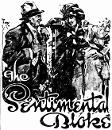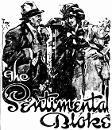AustLit
 8446372745420830197.jpg
8446372745420830197.jpg
Latest Issues
AbstractHistoryArchive Description
Adapted by Raymond Longford and Lottie Lyell from C. J. Dennis's collection of poems (The Songs of a Sentimental Bloke), the story concerns Bill ('the bloke'), a Sydney larrikin who vows to abandon his life of gambling and drinking when he falls in love with Doreen (who works in a pickle factory). His reformation comes about after he has been released from gaol, having been convicted of assaulting a policeman ('stoushing a John') during a raid on a two-up game.
Publication Details of Only Known VersionEarliest 2 Known Versions of
Works about this Work
-
Picturising Patois in The Sentimental Bloke
2023
single work
criticism
— Appears in: Australian Literary Studies , 19 December vol. 38 no. 3 2023;'Raymond Longford and Lottie Lyell’s 1919 adaptation of C.J. Dennis’s vastly popular 1915 verse novel, The Songs of a Sentimental Bloke, has long been regarded as the great classic of surviving Australian silent films, yet relatively little has been written about how text and image relate to each other within it. This article begins with a consideration of Dennis’s poems in the context of the contemporary fashion for dialect verse, which paradoxically represented comic, semi-literate speakers for the entertainment of an increasingly literate mass audience, often through popular recitals in which the magic lantern show offered an early model of incorporating poetry with projected images. It is argued that Longford and Lyell’s deployment of Dennis’s text in the form of first-person expository intertitles implies that Arthur Tauchert’s performance as Bill, the Bloke, may itself be read as a kind of filmic ‘recital’. This has implications for the different ways in which his patois has been ‘picturised’ throughout, and two scenes are analysed in detail: ‘The Play’, where Bill famously first encounters Shakespeare, and ‘The Stroot ’at Coot’, where he vanquishes a middle-class rival. Against the artifice of Dennis’s ‘larrikinese’, the film unfolds through a naturalistic style of acting and direction that, while it incorporates earlier modes of popular performance, also reimagines them into a style of comic, dramatic irony.' (Publication abstract)
-
The Sentimental Bloke
2023
single work
review
— Appears in: Senses of Cinema , November no. 107 2023;Lottie Lyell had her work cut out when she agreed to appear as the love interest of The Sentimental Bloke (Raymond Longford, 1919). The film was, and has usually been admired, as a bloke-ish affair. Its reputation – it was the highest grossing Australian film during the silent era, and has been called the ‘Great Australian Film’ – has been attributed to its (male) director. Raymond Longford is revered as “the only genuine creative talent the Australian cinema has produced” and “a remarkable filmmaker” with “unique vision”. His characteristic fusion of high Victorian melodrama, natural light and outdoor shooting, pacy realism, and dynamic cinematic techniques, led to comparisons with D.W. Griffith, then the most famous film director in the world.' (Introduction)
-
American Combine : Australasian Films Ltd., and Block Bookings
2015
single work
criticism
— Appears in: Studies in Australasian Cinema , vol. 9 no. 3 2015; (p. 241-252) 'The 1927–1928 Commonwealth Royal Commission on the Moving Picture Industry in Australia followed a series of public inquiries into the Australian cinema. One agenda of the Commission was to examine the dominance of American movies in Australian film exhibition. By concentrating on how the Commission explored this issue, as it related to the exhibition and distribution of Hollywood movies in Australia, here I will consider the extent to which Australian exhibition has been guided by and dependent on American movies. With the Commission established, in part, to explore the accusation of an American combine ruling the exhibition industry, and stunting the local production sector, the real question was whether the Commissioners would be persuaded to make recommendations to wrest the powers from America, and consequently redirect the local exhibition industry's dependence on Hollywood movies.' (Publication abstract) -
The Long Shadow of 1927
2015
single work
criticism
— Appears in: Studies in Australasian Cinema , vol. 9 no. 3 2015; (p. 230-240) -
A Masculine Romance : The Sentimental Bloke and Australian Culture in the War-and Early Interwar Years
2014
single work
criticism
— Appears in: Journal of Popular Romance Studies , vol. 4 no. 2 2014;'The Sentimental Bloke was a hugely popular multi-media phenomenon in Australia during the First World War and early interwar years. I explore the work as a heterosexual “masculine romance”: a love story expressing heterosexual romantic feeling from a masculine point of view and in a self-consciously masculine way. The Bloke phenomenon demonstrates that “ordinary” Australian men were more interested in certain forms of romantic popular culture than previously allowed. It also points to the fact that avowedly masculine constructions of romantic feeling were emerging in this period in response to criticism of elaborate Victorian-era expressions of romance on the one hand, and of commodified approaches to romantic love on the other. This point has implications for romance studies, which has paid little attention to the concept or even the possibility of masculine romance. In Australia, there was an insistent emphasis on plainness and straightforwardness as the hallmarks of a sturdily masculine approach to romance in the 1910s and 1920s. My hope is that this discussion will prompt other romance scholars to consider the particular inflexions given to masculine constructions of romance in other localities in the same period.'
Source: Abstract.
-
'The Sentimental Bloke' at West's
1919
single work
review
— Appears in: Brisbane Courier , 26 December 1919; (p. 7)
— Review of The Sentimental Bloke 1919 single work film/TV -
'The Sentimental Bloke'
1919
single work
review
— Appears in: Brisbane Courier , 27 December 1919; (p. 4)
— Review of The Sentimental Bloke 1919 single work film/TV -
'The Sentimental Bloke'
1919
single work
review
— Appears in: Brisbane Courier , 29 December 1919; (p. 7)
— Review of The Sentimental Bloke 1919 single work film/TV -
Town Hall - 'The Sentimental Bloke'
1919
single work
review
— Appears in: The Age , 6 October 1919; (p. 4)
— Review of The Sentimental Bloke 1919 single work film/TV -
Town Hall - 'Sentimental Bloke'
1919
single work
review
— Appears in: The Argus , 6 October no. 22832 1919; (p. 8)
— Review of The Sentimental Bloke 1919 single work film/TV -
The Bloke Mooches Back
2004
single work
column
— Appears in: Canberra Sunday Times , 20 June 2004; (p. 24-25) -
Geewhiz! The Blonde was a Bloke
2004
single work
column
— Appears in: The Age , 28 July 2004; (p. 8) Reports on the discovery during the 1970s of a US-marketed verstion of Longford's 1919 film, The Sentimental Bloke. The film has been re-constructed using the original Australian version and the US version. The 'new' film is to be screened in Melbourne on 26 October as part of the On Screen festival. -
Tapping Our Lovable Side
2005
single work
column
— Appears in: The West Australian , 15 January 2005; (p. 11) -
Two Remakes : Ideologies of Film Production 1919-1932
1982
single work
criticism
— Appears in: Nellie Melba, Ginger Meggs and Friends : Essays in Australian Cultural History 1982; (p. 33-59) -
Larrikin Ockers and Decent Blokes : The National Type in Australian Film Comedy
2009
single work
criticism
— Appears in: Creative Nation : Australian Cinema and Cultural Studies Reader 2009; (p. 154-165)
- Inner Sydney, Sydney, New South Wales,
- Urban,
- 1910s





